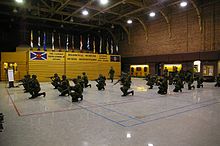

A drill hall is a place such as a building or a hangar where soldiers practise and perform military drills.
Description
In the United Kingdom and Commonwealth, the term was used for the whole headquarters building of a military reserve unit, which usually incorporated such a hall. Many of these drill halls were built through public subscriptions in order to support the local Volunteer Force which was raised in the late 1850s.
In the United Kingdom, these were later renamed Territorial Army (TA) Centres and later Army Reserve Centres (ARC)s. As well as a drill hall itself, they now usually feature other facilities such as a gymnasium, motor transport department, lecture rooms, stores, an armoury, administrative offices and the Officer's, Warrant Officers and Senior NCOs, and Junior Ranks Messes. Some Officer Training Corps, Army Cadet Force and Air Training Corps units are also co-located on the site of modern Army Reserve Centres, for example Blackheath drill hall.
Over 1,860 drill halls have been documented in England, with Historic England estimating that around 1,500 were extant in 2015. Fifteen purpose built drill halls are Grade II listed on the National Heritage List for England, dating from 1864 to 1907. The Grade II listed former Drill Hall on York Road, Great Yarmouth was built for the 2nd Volunteer Battalion Norfolk Regiment in 1867. Other drill halls were converted from extant buildings, including the now demolished St Nicholas Drill Hall in King's Lynn in Norfolk.
See also
References
- "Denbigh drill hall". Coflein. Retrieved 15 July 2017.
- "Galashiels, Paton Street, Mid Mill". Canmore. Retrieved 13 June 2017.
- "Drill Hall Register: A list of the locations of London Drill Halls since 1908" (PDF). Retrieved 14 May 2017.
- Historic England. "Drill Halls – Introductions to Heritage Assets".
- Carmichael, Katie. "Drill Halls: A National Overview – Historic England Report number: 6/2015". Historic England.
- Historic England. "York Road Centre (former Drill Hall), Great Yarmouth (Grade II) (1393653)". National Heritage List for England. Retrieved 5 May 2020.
- Graham, Katie. "The Former Drill Hall, York Road, Great Yarmouth, Norfolk – Historic England Research Report number: 95/2009". Historic England.
- "Chapel Street, King's Lynn, Norfolk: The History and Archaeology of the Chapel Street Car Park – Historic England Report number: 2/2018".
Further reading
- Osborne, Mike, 2006. Always Ready: The Drill Halls of Britain's Volunteer Forces, Partizan Press, Essex. ISBN 1-85818-509-2
External links
![]() Media related to Drill halls at Wikimedia Commons
Media related to Drill halls at Wikimedia Commons
This military-related article is a stub. You can help Misplaced Pages by expanding it. |